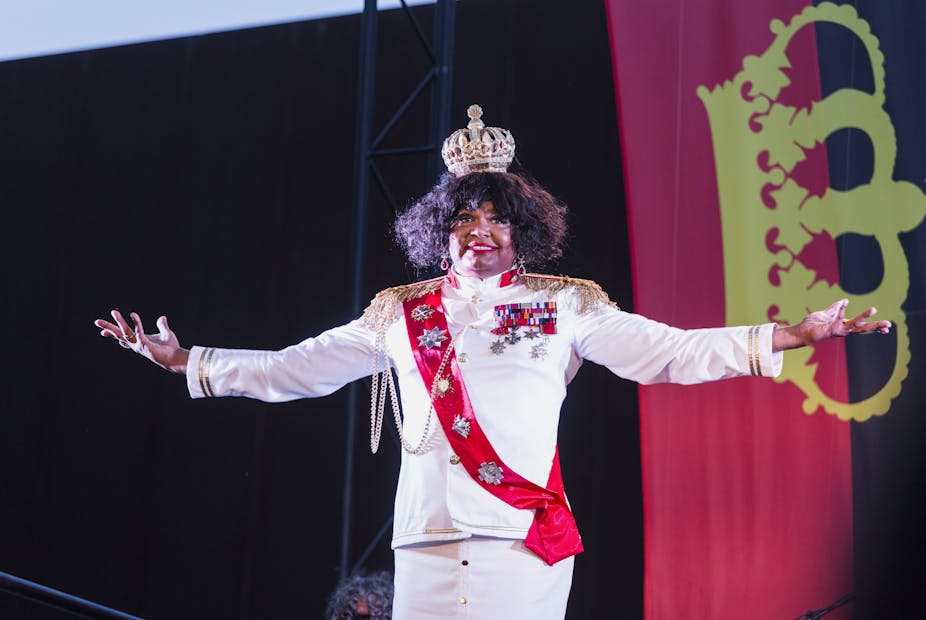Much conversation has been being sparked by a recent growth and competition in Aboriginal and Torres Islander comedy. Not since Basically Black, which screened on ABC Television in 1973, and Babakeueria, in 1986, have we really had a good dose of Aboriginal and Torres Strait Islander humour in mainstream entertainment.
Current examples include Blak Cabaret, a recent hit at the Sydney Festival and Melbourne’s Malthouse Theatre, and the Black Comedy sketch show on ABC.
Opinion is rife on what Aboriginal and Torres Islander humour is, and how it is expressed – even though Aboriginal and Torres Strait Islander peoples have delivered humour on a platter for centuries.
It has flourished via various media from humorous visual arts imagery, slapstick in dance (e.g. Djuki Mala nee The Chooky Dancers), satire in sketch (e.g. Basically Black), parody in life (see Babakeueria), the black comedy of history (e.g. Bindjareb Pinjarra), cabaret in performance (e.g. The Mary G Show), and most commonly the tradition of oral story telling with funny, true, made-up, exaggerated, dry, corny, obviously analytical jokes and yarns of the mob (e.g. Deadly Funny).
The diversity of our humour is prevalent and exists embedded within the diversity of our culture. Amusingly enough there has been a lack of awareness among non-Indigenous peoples about our humour, as discovered by Professor Lillian Holt on researching Aboriginal humour for a PhD, during which a documentary filmmaker stated that:
As a whitefella, I’ve never equated Aboriginal people and humour. It seems to me so incongruous.
Our communities – like all – are a mix of genders, ages, languages, religions, and beliefs. Humour can be situational, regional, age and gender relative. Unless you’ve been privy to it by making an effort to coexist and communicate with our people and culture, it has remained mostly covert within Indigenous communities themselves.
Continued ignorance about us as “people” and the human quality of humour and comedy that we have can be annoying. Anthropological and ethnographic views and analysis continue even about the existence of our sense of humour.
Across the board we as humans know that “if you don’t laugh, you cry”. Shared values among indigenous peoples worldwide note humour existing as a resistance to oppression, an expression of identity, a means of survival and a tool for healing. Many areas of Australian Indigenous life and culture continue to be misunderstood, unheard, misinterpreted, appropriated and even stolen.
Considering the impact of colonisation, racism, conflict and oppression, the health and wellbeing of Aboriginal and Torres Strait Islander peoples prevails through humour. So yeah, we have a sense of humour! The question is what should the principles of Blak comedy for mainstream audiences be?
Laughing ‘with’ or ‘at’
Are we giving permission for non-Indigenous viewers to laugh at us or with us? The challenge for Blak writers is this: how do we defuse and resist commonly held stereotypes and misconceptions?
Comedy is an opportunity to bridge the gap. For it to be successful there has to be universality, something audiences can relate to. It should provide moments that continue to challenge ideas of privilege and identity in Australian society without becoming assimilated for the viewing pallet of mass audience appeal.
What’s allowed to be said and what’s allowed to be laughed at? Some may argue that we can take power back via the use and ownership of words and stereotypes – such as the word “gin”. For others this word is still entrenched in trauma and the sexualising of Aboriginal women. By using derogatory terminology back on ourselves can we really empower and remove the historical damage?
Such debates are still needed generally in Australian society. Comedy does have it’s place in this debate, but the wider “race” debate also has it’s place in Australian comedy. A significant challenge for Blak humour in breaking the mainstream is: “Who really owns the humour?”
Obvious analogy, exaggeration and repetitive storytelling is commonplace. What black fulla hasn’t engaged in one of the many common jokes about “Closing The Gap”.
If we accept that Blak humour is unique to the Blak community, intellectual property and copyright presents real challenges for Indigenous writers and performers to not only manage the storytelling responsibilities from and to their communities, but also to protect theirs and their communities IP.
Of course, comedy is hard to write and perform; it’s said that good comedy offends as much as it amuses. Aboriginal and Torres Strait Islander humour does both and does it well. We just need to see more of it. The journey of moving away from modern-day minstrels is happening.
Indigenous Australians as a group need to continually reflect and participate in the process.

